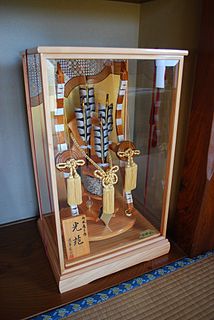 W
WAn azusa yumi , is a sacred bow (yumi) used in certain Shinto rituals in Japan, as well as a Japanese musical bow, made from the wood of the Japanese azusa or Japanese cherry birch tree. Playing an azusa yumi forms part of some Shinto rituals; in Japan, it is universally believed that merely the twanging of the bowstring will frighten ghosts and evil spirits away from a house. In Japanese poetry, the word azusa yumi functions as a makurakotoba. The term, Azusa Yumi, is inter-changeable with the term, Hama Yumi.
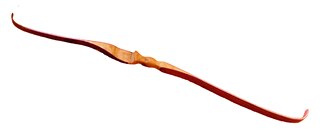 W
WIn archery, the shape of the bow is usually taken to be the view from the side. It is the product of the complex relationship of material stresses, designed by a bowyer. This shape, viewing the limbs, is designed to take into account the construction materials, the performance required, and the intended use of the bow.
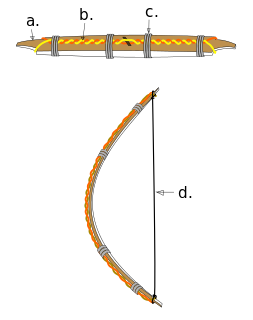 W
WA cable-backed bow is a bow reinforced with a cable on the back. The cable is made from either animal, vegetable or synthetic fibers and is tightened to increase the strength of the bow. A cable will relieve tension stress from the back of the bow by raising its neutral plane: the border between the back of the bow that stretches and the belly of the bow that compresses when bent. A good cable-backed bow can thus be made of poor-quality wood, weak in tension. The material, the diameter, the distance from the back of the wooden element, and the level of stress (tightness) of the cable determines how much it relieves tension stress from the wooden element of the bow and increases the power of the shot.
 W
WA composite bow is a traditional bow made from horn, wood, and sinew laminated together, a form of laminated bow. The horn is on the belly, facing the archer, and sinew on the outer side of a wooden core. When the bow is drawn, the sinew and horn store more energy than wood for the same length of bow. The strength can be made similar to that of all-wood "self" bows, with similar draw-length and therefore a similar amount of energy delivered to the arrow from a much shorter bow. However, making a composite bow requires more varieties of material than a self bow, its construction takes much more time, and the finished bow is more sensitive to moisture.
 W
WIn modern archery, a compound bow is a bow that uses a levering system, usually of cables and pulleys, to bend the limbs.
 W
WA crossbow is a ranged weapon using an elastic launching device consisting of a bow-like assembly called a prod, mounted horizontally on a main frame called a tiller, which is hand-held in a similar fashion to the stock of a long firearm. Crossbows shoot arrow-like projectiles called bolts or quarrels. A person who shoots crossbow is called a crossbowman or an arbalist.
 W
WThe English longbow was a powerful medieval type of longbow about 6 ft (1.8 m) long used by the English and Welsh for hunting and as a weapon in warfare. English use of longbows was effective against the French during the Hundred Years' War, particularly at the start of the war in the battles of Sluys (1340), Crécy (1346), and Poitiers (1356), and perhaps most famously at the Battle of Agincourt (1415). However they were less successful after this, with longbowmen having their lines broken at the Battle of Verneuil (1424) though the English won a decisive victory, and being completely routed at the Battle of Patay (1429) when they were charged by the French mounted men-at-arms before they had prepared the terrain and finished defensive arrangements. The Battle of Pontvallain (1370) had also previously shown longbowmen were not particularly effective when not given the time to set up defensive positions.
 W
WThe Korean Bow is a water buffalo horn-based composite reflex bow, standardized centuries ago from a variety of similar weapons in earlier use. Due to its long use by Koreans, it is also known as Guk Gung. The Korean bow utilizes a thumb draw and therefore employing the use of a thumb ring is quite common. The Korean thumb ring is somewhat different from the Manchu, Mongol, or the Turkish Thumb Ring, as it comes in two styles, male and female. Male thumb rings are shaped with a small protrusion that sticks out that the bowstring hooks behind, while the female thumb ring simply covers the front joint of the thumb as protection from getting blisters.
 W
WGandiva is a divine bow of Arjuna, one of the Pandavas from the Hindu epic Mahabharata. The bow was made by Brahma.
 W
WThe hama yumi is a sacred bow used in 1103 A.D. in Japan. This bow is said to be one of the oldest and most sacred Japanese weapons; the first Emperor Jimmu is always depicted carrying a bow. The term, Hama Yumi, is inter-changeable with the term, Azusa Yumi.
 W
WThe Hoyt Ruckus is Hoyt's performance driven youth compound bow. It measures 29.3/4 inches axel to axel. It has a huge range of adjustability with draw lengths going from 18-28 inches at 1 inch increments. This bow can be bought at 10-40 or 20-50 pounds draw weight. The bow itself weighs 2.8 pounds. This bow can be used for hunting or target archery.
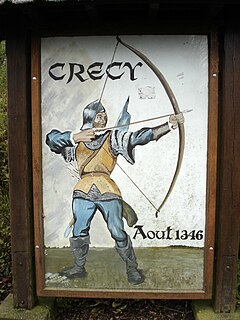 W
WA longbow - in its time just known as warbow in contrast to a hunting bow - is a type of tall bow allowing the archer a fairly long draw. A longbow is not significantly recurved. Its limbs are relatively narrow and are circular or D-shaped in cross section. Flatbows can be just as long; the difference is that, in cross-section, a flatbow has limbs that are approximately rectangular.
 W
WThe Manchu bow is a type of composite recurve bow historically used in Manchuria, and subsequently spread to China, Mongolia, and Tibet during the Qing dynasty. It is similar in construction and likely shares roots with the medieval Mongol bow. It is characterized by very large siyahs, long draw length, prominent string bridges, and use with typically large and heavy arrows. Due to its extensive usage outside Manchuria, this bow is also often identified as a Chinese bow or Mongol bow, and during the 17th century, its widespread usage almost completely displaced all other types of bows in the Qing Empire.
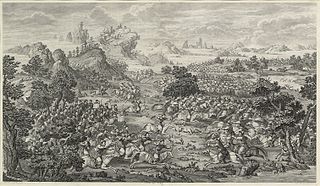 W
WThe Mongol bow is a type of recurved composite bow used in Mongolia. "Mongol bow" can refer to two types of bow. From the 17th century onward, most of the traditional bows in Mongolia were replaced with the similar Manchu bow which is primarily distinguished by larger syiahs and the presence of prominent string bridges.
 W
WIn archery, a recurve bow is one of the main shapes a bow can take, with limbs that curve away from the archer when unstrung. A recurve bow stores more energy and delivers energy more efficiently than the equivalent straight-limbed bow, giving a greater amount of energy and speed to the arrow. A recurve will permit a shorter bow than the simple straight limb bow for given arrow energy, and this form was often preferred by archers in environments where long weapons could be cumbersome, such as in brush and forest terrain, or while on horseback.
 W
WA self bow or simple bow is a bow made from a single piece of wood. Extra material such as horn nocks on the ends, or built-up handles, would normally be accepted as part of a self bow. Some modern authorities would also accept a bow spliced together in the handle from two pieces of wood.
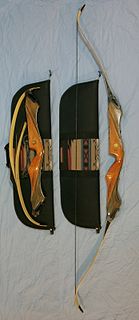 W
WA takedown bow is a bow assembled out of a riser and two limbs to make a working bow when strung.
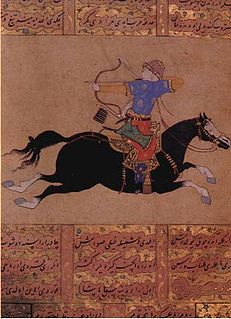 W
WTurkish archery is a tradition of archery which became highly developed in the Ottoman Empire, although its origins date back to the Eurasian Steppe in the second millennium BC.
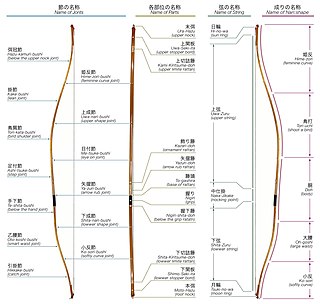 W
WYumi is the Japanese term for a bow. As used in English, 'yumi' refers more specifically to traditional Japanese asymmetrical bows, and includes the longer daikyū and the shorter hankyū used in the practice of kyūdō and kyūjutsu, or Japanese archery.